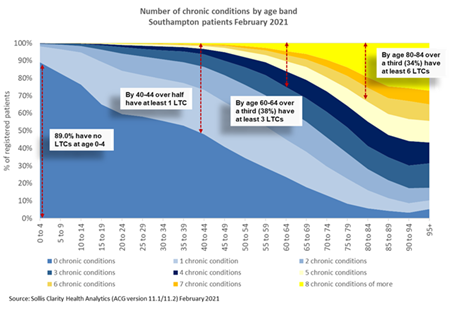
Chronic condition projections
 Chronic condition projections
Chronic condition projections
In 2021, it is estimated that 261,729 people live in Southampton and this is predicted to grow by 6.3% to 278,210 by 2028. The over 65 population is predicted to increase from 38,169 to 44,800 (a 17.4% increase). This is largely because the increases seen in life expectancy over the last few decades mean that people are living longer. However, lower levels of healthy life expectancy suggest, it is often with long-term conditions (sometimes called chronic conditions) and an extended period of poor health or disability.
This has implications on the demand for health and adult social care services. According to NHS England, nationally people with long-term conditions (LTCs) are:
- More likely to use health and care services
- Less likely to be working than the general population; 72% of the general population are in work whereas 59% of people with LTCs are in work. Only 35% of people with a mental health condition are in work
- Of the people who report that they live with long-term conditions, 24% have two LTCs and 20% live with three or more LTCs
- 72% of people with long-term conditions use their care plan to manage everyday health
- 18% of people living with a long-term condition smoke
- Long-term conditions account for:
- 50% of GP appointments
- 64% of all hospital outpatients appointments;
- 70% of inpatient bed days
- 70% of health care spend
 An ageing population compound this issue as people tend to develop more long-term or chronic conditions as they grow older. In Southampton, in 2021, by the age of 40 to 44 years, over half of Southampton registered patients have at least one chronic health condition; by the age 60 to 64, over a third have at least three chronic conditions and by the age 80 to 84, almost a third have at least 6 chronic conditions, as can be seen in the chart.
An ageing population compound this issue as people tend to develop more long-term or chronic conditions as they grow older. In Southampton, in 2021, by the age of 40 to 44 years, over half of Southampton registered patients have at least one chronic health condition; by the age 60 to 64, over a third have at least three chronic conditions and by the age 80 to 84, almost a third have at least 6 chronic conditions, as can be seen in the chart.
Multi-morbidity not only increases with age, but for those Southampton residents living in the most deprived areas of the city it appears to be occurring much earlier in life. The 20% most deprived neighbourhoods in the city have over twice the proportion of residents living with 3 or more chronic conditions by their mid to late thirties, compared to residents living in the 20% least deprived neighbourhoods.
A mapping exercise looking at the prevalence of different chronic conditions by neighbourhood shows the current variations of conditions across the city. Available in the first half of the side set available below.
In the context of an ageing population, increases in ill health and a reduction in resources, there is a need to better understand how this could impact on future demand for health and social care services in Southampton.
Using the current prevalence of chronic health conditions, an analysis was undertaken in 2022 to model and project the number of Southampton residents with chronic health conditions in the future.
An overview of this analysis, along with the results can be found in the second half of the slide set which can be downloaded below.
Resources
Current and predicted chronic conditions and predicted need for help - October 2022
Slide set on the current and predicted chronic conditions and predicted need for help
NHS England - Long term conditions
NHS England's work on improving services for people with long term conditions. Including information on specific service improvement areas.
Last updated: 26 October 2022